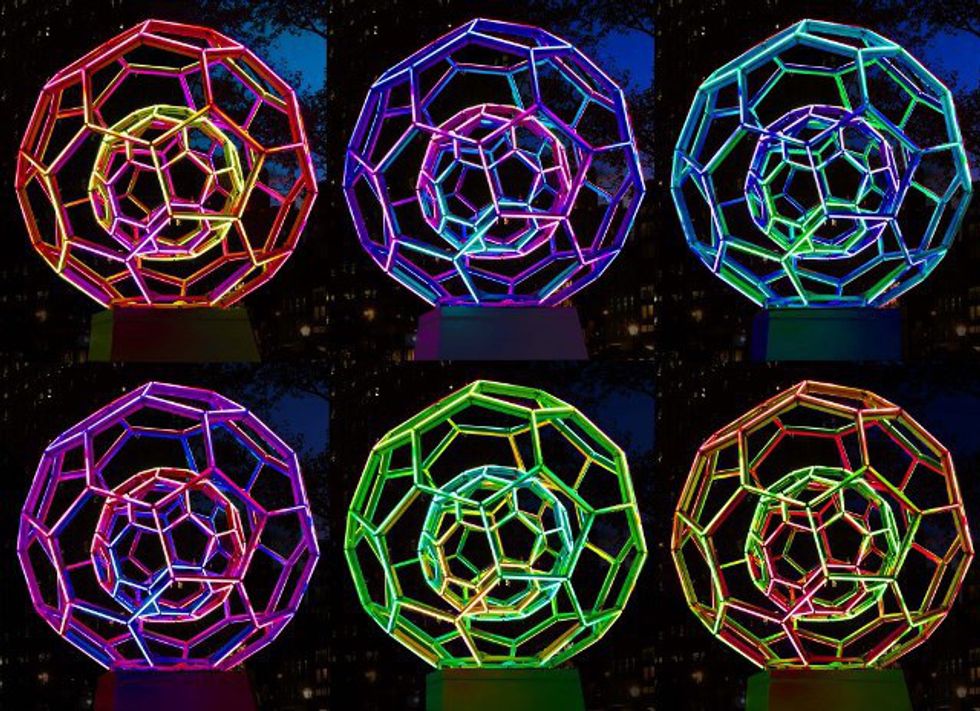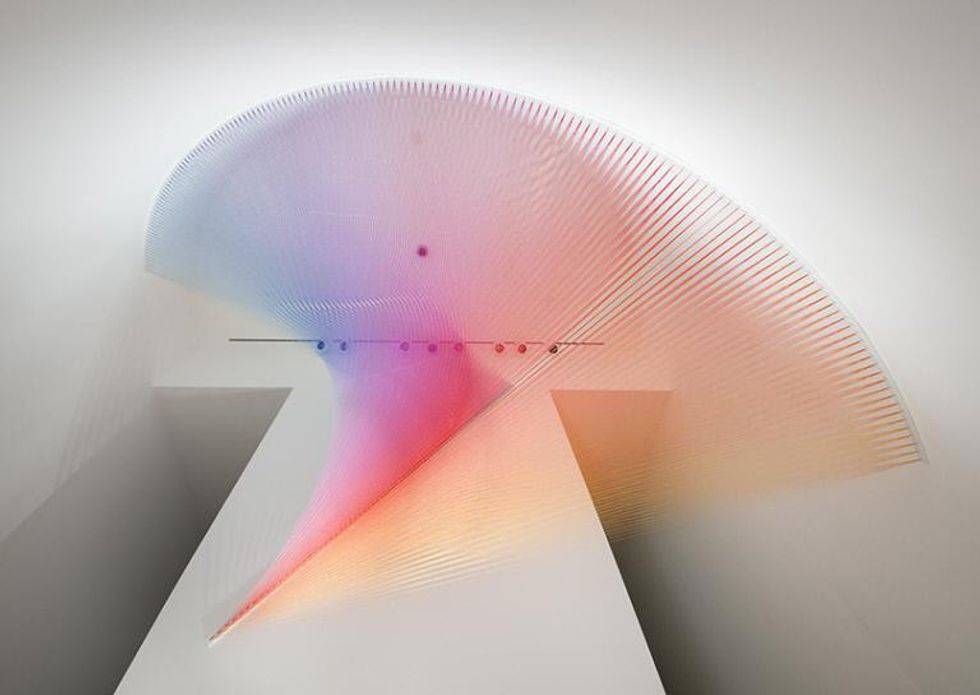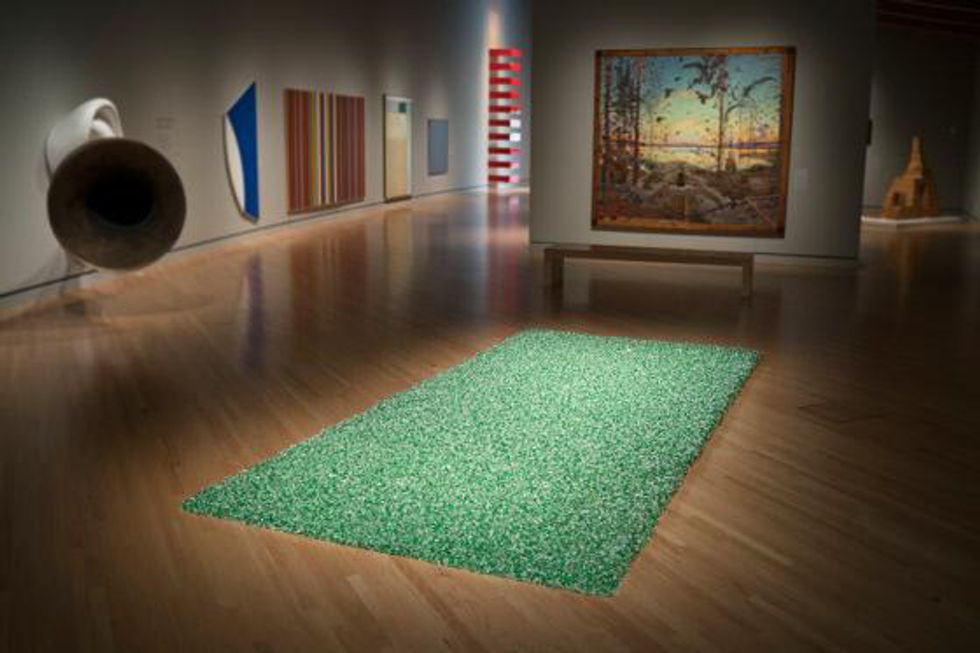Recently moving to Northwest Arkansas, I've gotten the opportunity to experience an award-winning museum in Bentonville Arkansas. The museum, Crystal Bridges Museum of American Art, showcases unique American artwork from around the world-free to the public. After visiting a few times, here are my favorite pieces:
1. Buckyball
Buckyball, which sits outside the museum near the parking lot, features aluminum tubing clad with LED lights atop an aluminum plinth. Many a time I have laid out on one of the surrounding anti-gravity benches to take in the sculpture. The light has a very powerful effect, that changes the way we think about art by harnessing the power of fire. It causes a response that brings out feelings of things seen in nature: the sunset, the surface of the water, or bright fire. The cool thing about Buckyball is the fact that it brings people together that may not ever visit a museum-because it’s a public art piece.This particular art piece can engage with all kinds and ages of people, because light has a universal quality. Anyone can look at light and have some sort of response. Public art like Buckyball gives the opportunity for space to enjoy technology-and art-in an open-ended way to create community. This piece also meets the standards of status of art. It was man-made, expressive through the artist, and a full expression of the truth that he perceives. Here is a quote from the artist (Leo Villareal) that I thought was interesting:
“So were you still thinking of yourself as an artist at that point? I was, but I was not really sure how I was going to express that. It wasn’t until 1997 that I made my first light sculpture. I came back to New York and I was teaching at NYU, and the exciting moment for me was connecting software and light. A lot of new media artwork involved screens or projections, which I found not to be compelling, visually. It didn’t connect back to what I’d seen as a student and loved in art history. It didn’t have the impact that art had, the impact of a Rothko painting or a sculpture. But when I made the first light piece, I realized that light had this power to be very impactful and engaged and sensorial, but also was a way to visually manifest the code that I was using. So I found that connection, and that was really an essential moment for me.”
At the same time, this artwork does gives a message that helps me define its Christian viewpoint. This particular piece uses the ideas present in nature to create a piece of art that Christians and non-Christians alike can admire because of the creation it represents.
2. Plexus No. 27
Another artwork I love at Crystal Bridges is the Plexus No. 27. This piece has to be my favorite at Crystal Bridges by far. Every time I see it, there’s that wow factor. Made up of multi-colored sewing thread, the artwork meets status as art in that it is man-made, self-expressive, and gives off the author’s truth. Gabriel Dawe, the artist, strings miles of colored thread between hooks on the walls, creating mesmerizing color, form, and shadows. As you move around it, the overall shape of the work changes depending on your position in the space. It combines art and optical illusion, and the lines seem to be kinetic in a sense, changing as you move below the structure. The artist grew up watching his grandmother create hand embroidery. He transforms a traditionally feminine medium into an approach that reminds us that each viewpoint comes from a unique set of circumstances, and our shared experience is to be open to multiple points of view. From a Christian standpoint, the piece teaches you that situations can look different at different angles, and people shouldn’t be judged for just one mistake. It can remind you that people are made up of different strings of DNA, but they are all represented as a beautiful piece of creation by the Creator.
3. "Untitled" LA
One last artwork I would like to mention is the “Untitled” (LA) piece by Felix Gonzalez-Torres. I remember the first time I encountered this piece back in May. I remember thinking that it looked like glass grass from a distance and I thought how in the world did an artist make a rug out of glass. Then I realized it was individual pieces of green cubes. And that they were actually pieces of candy. I found the plaque on the wall and read about it. Realizing that I was supposed to experience the art in more ways than just sight, I picked up a piece and ate it. It truly was the weirdest artwork I had seen, tasted, and touched in my life. And certainly the first time I was able to taste art in a museum! The artist’s emotions are conveyed in the whole experience: you can literally taste the battle with aids that he endured. The piece is definitely man-made, self-expressive, and expresses the artist’s truth as a he perceives the world that is crashing down around him. This piece can be seen through a Christian viewpoint as the church being a body of believers. The candy is a metaphor for the body of Christ: a crazy layer of people that fit together in many different forms to do the work set out for us.
All three of these pieces qualify as art; they each are unique in their specific tools and mediums. They are all pure in form, and popular in audience. They are not cultivated for certain types of people; they were made to be enjoyed and observed by many. But they were all created by a man-made creator, who were dreamed up by the ultimate Creator.
























